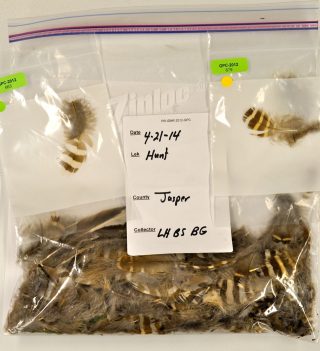In the mid 1800s, the greater prairie chicken numbered in the millions on the tall-grass prairies of Illinois. Its distinctive hooting moan was the sound track for early spring mornings, and signified the elaborate rituals of reproduction were again in bloom.
The male greater prairie chicken puts it all on the line to attract a mate. It performs a rapid stutter-step dance and puffs out the large orange air sacks on its neck to create a characteristic “booming” call. It raises two neck tufts straight up, spreads its tail feathers, and droops its wings as it rushes to and fro like a small bull. Then come the scuffles between males competing for a hen, and the feathers really do fly.
Tympanuchus cupido pinnatus, a member of the grouse family, thrived in pre-urban, pre- agricultural Illinois. But numbers dwindled as the native prairie fell before the plow, and cities sprang up in its stead. By 1962 there were 2,000 left in Illinois; in 1998 only 46 remained.
In the 1990s, the Illinois Department of Natural Resources began augmenting the populations with birds “translocated” from other plains states. The idea was that newcomers would not only bolster the populations, but also breed with Illinois birds and thus reverse dwindling genetic diversity. And translocations did increase the greater prairie chicken’s numbers. It was considered a successful conservation effort, not only with prairie chicken, but also with regard to other small, isolated, and inbred populations: the Florida panther, European adder and big horn sheep.
Subsequent studies, however, have raised questions about how effective the technique is at “genetic rescue.” Translocations may initially promote an increase in numbers, but do they translate into genetic diversity and therefore long-term sustainability? University of Arkansas biologists Marlis and Michael Douglas believe that for the greater prairie chicken, the answer is no.
The Douglases, along with graduate student Steven Mussmann, postdoc Whitney Anthonysamy and collaborators from Illinois, spent four years extracting DNA from feathers shed at breeding sites, known as “leks,” to determine how interbred the birds really are. The research was funded in part by endowments of the University of Arkansas in the J. W. Fulbright College of Arts and Sciences, along with a grant from the Illinois Department of Natural Resources.
They found little evidence that translocations had improved genetic diversity, indicating that the imported birds either had failed to interbreed extensively with the local populations, or simply wandered off.
“We can now look back and say they faded again, and very quickly,” said Michael Douglas, who holds the 21st Century Chair in Global Change Biology. “Thus, It really wasn’t a rescue. It was a temporary enhancement in numbers, but not a rescue from the threat of extinction.”
“This is how science works,” he added. “More data and an increased resolution allow such issues to be re-examined again.”
That doesn’t mean translocations were a failure, noted Marlis Douglas, who holds the Bruker Professorship in Life Sciences. “The translocations bought time for the prairie chicken in Illinois,” she said, “but in this instance, it was not the path to a self-sustaining population.”
Restoring native prairie habitat is the real solution, she added. “The best way to maintain a genetically diverse population is to increase the population size, but to do so, more habitat is needed.”
Given the state’s reliance on agriculture, that’s not likely to happen soon. But by placing the greater prairie chicken on the federal endangered species list (it is only state listed now), could bring additional resources to the task of reclaiming marginal farming land, thus increasing the extent of prairie habitat. Creating a corridor, a physical connection, between the two disparate prairie chicken areas in Illinois would also encourage more breeding between the isolated populations.
But the worst thing would be to assume that translocations have solved the problem.
“If nothing is done, the greater prairie chicken will be threatened with extinction again,” Marlis said.








You must be logged in to post a comment.